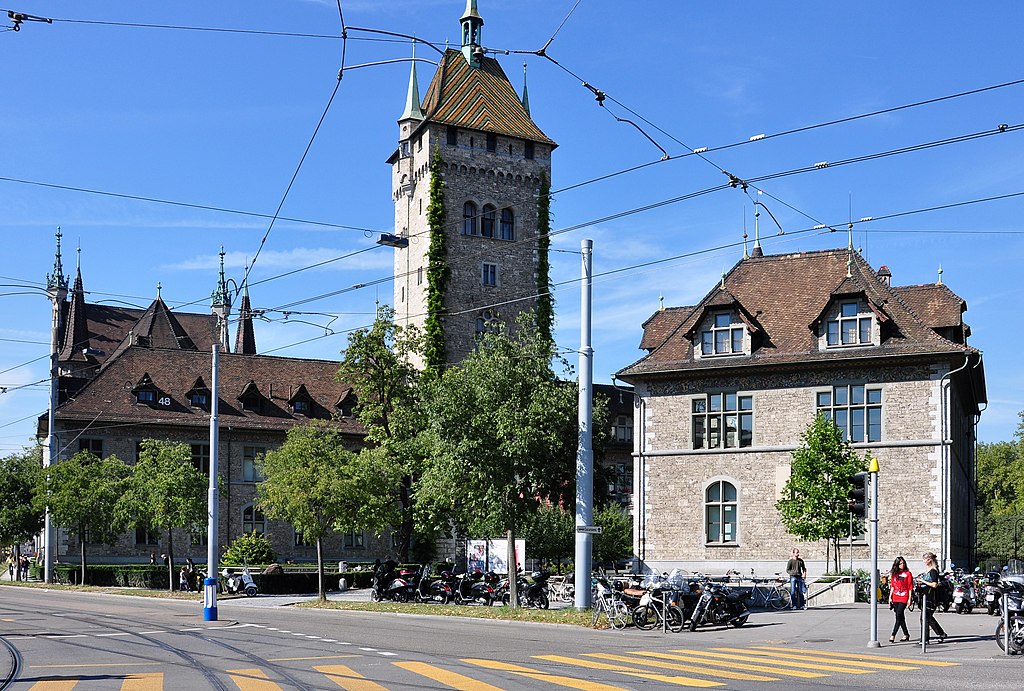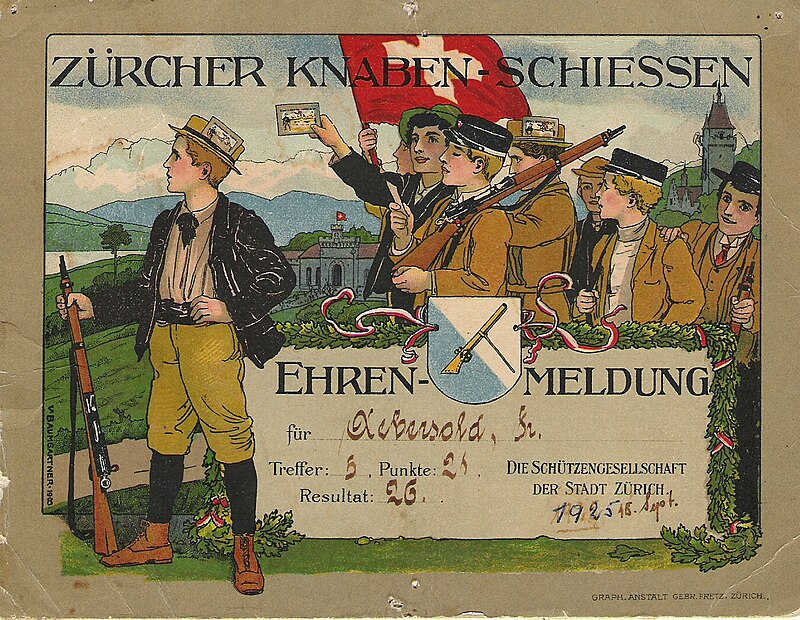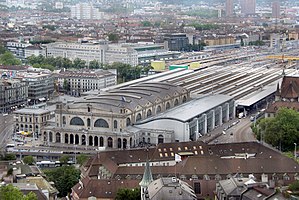Zürich, 30 December 2015
You have arrived at “the Haa Bay” as the locals call it: Zürich´s Main Station or Hauptbahnhof.
You should be impressed.
There are 3,000 trains, carrying around 350,000 passengers, arriving and departing daily on 30 tracks.
The station is one of Switzerland´s oldest.
The first station on this site was opened in 1847 by the Swiss Northern Railway as the terminus for a railway connecting Zürich and Baden (14 miles / 23 km apart).

This was the first railway constructed entirely within Switzerland.
The first train departed Zürich at 1 pm on 7 August 1847, carrying 140 invited passengers.
The railroad followed the south bank of the Limmat and took 45 minutes.
A scheduled service started two days later with four trips daily in each direction.
Zürich´s gentry were impressed.
Before the arrival of the railway their servants had to set out from Baden the night before on foot.
Why?
There were special buns that under Canton law could only be made in Baden.
These buns originated in Milan during the 17th century when that city was under Spanish control.
These Spanish buns from Baden, once safely in Zürich, were used by the gentry to impress their guests at high society tea parties.
So the servants would use the new railway to buy buns in Baden.
Thus this railway line was soon dubbed the Spanish Bun Railway.
The station building seen today was completed in 1873, and from the outside this neo-Renaissance station looks much as it did when it was first built.
In front of the station is a monumental fountain, added in 1889, to the memory of Swiss politican and railway entrepreneur Alfred Escher (1819-1882).

Escher initiated the construction of the Gotthard Railway and was a founder of what is today the Credit Suisse Bank.

All this talk of buns has made you hungry.
Step back inside the station.
While the main concourse has remained unchanged in its sombre sobriety, above your head is a sculpture suspended from the ceiling.

Meet your Guardian Angel, created by the French sculptress Niki de Saint Phalle (1930-2002).
After you´ve eaten, and maybe after a moment of quiet reflection in the Station´s tiny chapel…
(See Reformation by the River and the Railway Tracks of this blog.)
…step outside and look for the River.
Follow the River and walk on behind the Swiss National Museum to where the sea green Limmat meets the coffee coloured Sihl River.

Here is the Swiss National Museum, Zürich.
At the point where these two rivers converge is the peaceful Spit Place Park (Platz Spitz Park), as the park occupies a spit of land separating the rivers.

Looks boring, unimaginative?
Today, perhaps, but it was not always so.
In medieval times, this park, just outside the city walls, was used for grazing animals and for military drills.
In the early 15th century it became a shooting range.
During the 16th century target shooting competitions were staged here.

Zürich still has a shooting competition for teenagers.
The Knabenschiessen takes place on the second weekend in September, accompanied by Switzerland´s largest fun fair.
In 1780 the park became a place for promenades, a French-style pleasure park with riverside avenues and imposing trees.

Here were installed memorials to the City´s great men.
Among them are Saloman Gessner (1730-1788), the founder of the Züricher Zeitung newspaper, and Wilhelm Baumgartner (1820-1867), choir director, pianist and composer.

Saloman Gessner (1730-1788)

Wilhelm Baumgartner (1820-1867)
The construction of the Haa Bay in 1846 brought about the end of the old park and what remained would be, by 1883, transformed into an English-style landscape garden with a bandstand and the Swiss National Museum.

The Gazebo is a vestige of the first Switzerland’s National Exhibition of 1883.
It was first built to be a musical pavilion, a function it still serves to this day.
The meeting of the river waters would make this park Irish novelist James Joyce´s favourite spot in all of Zürich.

Alone
The noon’s greygolden meshes make
All night a veil,
The shorelamps in the sleeping lake
Laburnum tendrils trail.
The sly reeds whisper to the night
A name—her name—
And all my soul is a delight,
A swoon of shame. (James Joyce)
He too arrived, like many still do, at the Haa Bay in October 1904, en route to Trieste.
He was on his honeymoon, newly married to Nora Barnacle, and they stayed for a week in a nearby guesthouse.
Ten years later, the Joyces found themselves back at the same guesthouse with their two children, Giorgio and Lucia, having pawned their furniture in Trieste to escape wartime Austria.
Zürich in 1915 was a haven away from the First World War not only for writers like Joyce, but for also revolutionaries and artists, including the Russian revolutionist Vladimir Ilyich Lenin and the emigré artists who founded the Dadaism art movement.
So many refugees arrived at this time that Bahnhofstrasse was dubbed “Balkanstrasse”.
Lenin would leave Zürich from the Haa Bay on 9 April 1917, crossing Germany without stopping, in a sealed carriage.
Germany allowed Lenin safe passage in the hope that Lenin would destabilise Russia.
Lenin did not disappoint.
During the late 1980s, officials designated the park as an area where drug dealing and drug usage was deemed legal.
It was an attempt to bring out the problem of drug use into the open and address it head on through the provision of pure drugs and clean syringes to contain the spread of disease.
Welcome to Needle Park.

“The strange scene has been a fixture in Zurich for several years, tolerated by city officials who are convinced that drug use should be regarded as a sickness rather than a crime.
Social and medical workers estimate that about 300 to 400 heavy drug users live in the park without shelter, toilets or showers, and that as many as 3,000 others pass through daily to buy and use drugs.

Midway of the grotesque carnival is a concrete path along the edge of the Limmat River, lined with makeshift counters covered with neatly arranged spoons, bottles of water and paper cups bristling with slender, disposable syringes.

The crowd thickens as night falls and drug hustlers work their way through the sea of bodies clogging the path, calling out ”Sugar, sugar, fine sugar!” when they mean heroin, and ”Cokay, cokay!” for cocaine.
The other night, three men crouched under a park lamppost, dividing a white powdery pancake of heroin with a Swiss Army knife.
Next to them, a woman lay in the dirt in a stupor.
Four or five men were intensely working needles into their arms.
A woman in a striped sweater probed for veins in one hand, blood streaming down her fingers, as a woman in leather pants and stained blouse wobbled past, a bloody syringe dangling from her neck.”
(27 September 1990, New York Times)
Police were not allowed to enter the park or make arrests.
Clean needles were given out to addicts as part of the Zurich Intervention Pilot Project, or ZIPP-AIDS program.
However, lack of control over what went on in the park caused a multitude of problems.
Drug dealers and users arrived from all over Europe, and crime became rampant as dealers fought for control and addicts (who numbered up to 20,000) stole to support their habit.
The once-beautiful gardens had degraded into a mess of mud and used needles.

Emergency services were overwhelmed with the number of overdoses, which were almost nightly.
Was the initiative a conscious plan to deal with Zürich´s drug problem?
Or was it a kneejerk reaction to an overwhelming humanitarian crisis?
Most people were reluctant to even acknowledge there even was a problem, especially since a quarter of the addicts were foreigners.
At first, the Swiss tried to make the problem disappear with a law enforcement solution.
They repressed drug use and trafficking with arrests and incarceration.
The proportion of the prison population jailed for drug use increased to 80% at one time.
Police began to push the addicts out of Needle Park.
Addicts moved out of the center of town but simply regrouped around an abandoned train station.
Forms of drug addiction treatment were abstinence-based until methadone came along.
Prevention efforts targeted younger Swiss citizens with avoidance messages.
Then, according to some analysts, two forces changed the way the Swiss addressed the problem.
One analyst speculated that the ruthless law enforcement approach ran counter to the native Swiss tendencies toward tolerance and inclusion.
And then in the 1980s, HIV and AIDS began to spread through the population of addicts.
And so the country took a new approach toward substance abuse and addiction among its citizenry.
The country began to look for other ways to eliminate the worst aspects of their drug abuse and addiction problems.
Needle Park was officially closed on 4 February 1992.
In 1992, the state approved a trial of Heroin Assisted Treatment (HAT), a treatment program in which those who had failed at other methods of treatment could receive medically-controlled doses of heroin every day and thus hopefully be integrated back into society.
The park was cleaned up and reopened in 1993.
This trial ran until 1997 and was evaluated as successful in alleviating some of the worst aspects of addiction – the spread of disease, criminality and prostitution to support the habit, and the exclusion of the person by the rest of society.
Whatever your opinion about the use of hard drugs, it should be borne in mind that today Switzerland has one of the most progressive drug prevention policies on the European continent, with needle exchanges and injection rooms supervised by trained staff.
Switzerland is the only country in the world to operate a widespread, government-funded programme of managed heroin prescription.
(The enforcement of the prohibition on cannabis is spotty, because around 500,000 Swiss people are believed to use cannabis regularly or occasionally.
So as you wander through the streets and parks of Switzerland, don´t be surprised to catch an occasional whiff of “wacky tabaky” in the air.)
It’s estimated that about half of all opiate addicts are receiving treatment.
Only about 3% are in HAT programs, while the remainder, by and large, are in methadone/substitution programs.
In 2007, 20,000 people received substance abuse treatment in Switzerland.
A little less than half of these people were in drug treatment facilities for opiate addiction.
Another quarter entered drug rehabs for help with cocaine addiction and about a fifth of those in drug treatment facilities for their addictions to cannabis.
While these programs do reduce some of the harmful aspects of addiction, what they do not do – what they do not teach – what they do not insist on is the development of a completely drug-free life.
When an addict turns his or her life around fully and leaves all drugs and alcohol behind, he or she can truly experience the joy of living again.
Addicts can find the solution they need to drug or alcohol addiction.
A thorough detoxification followed by counseling and life skills training enable a person in a drug program to see things in a whole new light so they can live an enjoyable, productive life again.
Sit upon a park bench and watch the rivers flow by.
“Picture yourself in a boat on a river
With tangerine trees and marmalade skies
Somebody calls you, you answer quite slowly
A girl with kaleidoscope eyes
Follow her down to a bridge by a fountain
Where rocking horse people eat marshmallow pies
Everyone smiles as you drift past the flowers
That grow so incredibly high
Newspaper taxis appear on the shore
Waiting to take you away
Climb in the back with your head in the clouds
And you’re gone”
Beatles, “Lucy in the Sky with Diamonds”

Sources: Only in Zürich, Duncan Smith; Wikipedia; Narconon Switzerland)


